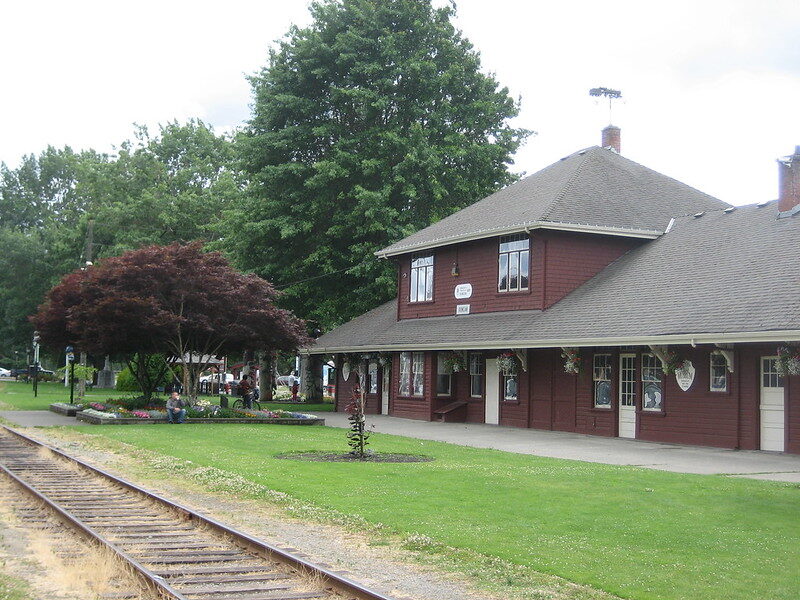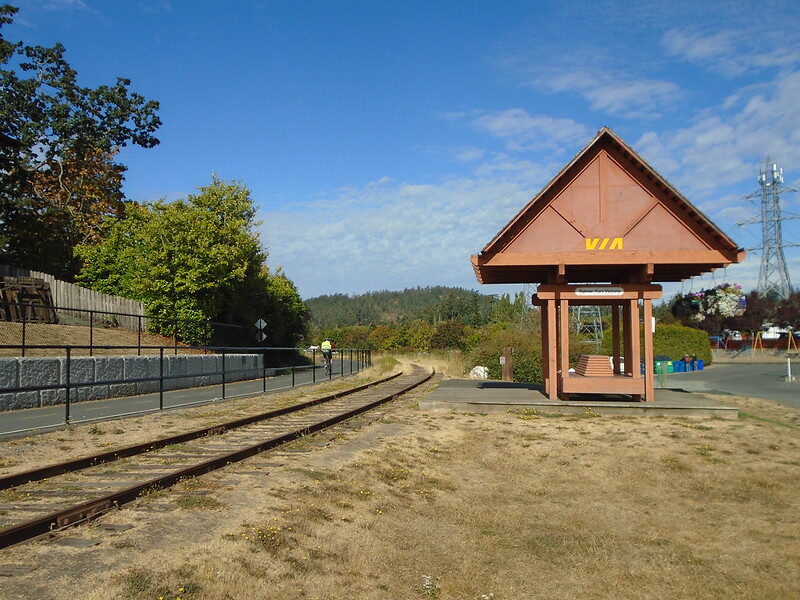The Island Railway suspended operations on March 18, 2011, due to safety concerns about the condition of the tracks. Plans to reopen the line continue to this day. In fact, one of the items of correspondence at the Strathcona Regional District’s May 13th Board Meeting was an email from Nanaimo Mayor Leonard Krog.

An Unrepentant Advocate
He wrote, “I remain an unrepentant advocate for timely public capital expenditure and upgrading the railway is so obviously a project whose time has come. As the ICF has pointed out the ties could be produced right here on Vancouver Island. We have found billions to put in people’s pockets to get us through this economic crisis and pandemic so why not employ them in this project which is a proven way to reduce our carbon footprint?”
The 225 km long railway from Victoria was once meant to reach Campbell River. Only World War I intervened, and construction stopped in Courtenay.
(The old E&N railway originally stretched between Esquimalt and Nanaimo, and was built between 1883 and 1886.)
There are no plans to build a Campbell River line today, but the five Regional Districts and fourteen First Nations in the Island Corridor Foundation (ICF) would like to see the Island Railway resume service.

Cost of the Project
The WSP Canada Group prepared a 108 page report prepared for B.C.’s Ministry of Transportation and Infrastructure. They estimate it would cost as much as $729 million, in 2020 dollars, for the trains to run again. This would include a 64 kilometre section from Parksville to Port Alberni. However this estimate does not include the unknown cost of repairing bridges, hazards from rockfalls and changing demand.
The Island Corridor Foundation agrees with the reports base construction assumptions (materials, labour, scope), but not the contingency costs for project management, engineering, construction supervision, unknown contingencies and First Nations consultation.
“These additives amount to a total of 97% increase in the total estimate over the base construction cost estimate resulting in an almost doubling of the estimate base construction costs.”
If the ICF is right, the actual cost might be closer to $326 million.

Why not Vancouver Island?
An ICF powerpoint presentation called the Return of Rail to Vancouver Island states that the province appears to be far more willing to spend money in Metro Vancouver than Vancouver Island. The projected costs for the Surrey-Langley line, Millennium Line and Expo Mill upgrade is $7.9 billion, or $3,000 for every resident. By way of comparison, if it costs $500 million to reopen the Island Railway, this works out to only $625 per resident.
27% of British Columbia’s greenhouse gas emissions come from road transportation.
Railways have a third of the emissions, per person.
Three Stages Of Restoration
The WSP report proposed that rail service be restored in three stages:
- Initial – between two and four passenger trains and two and four freight trains (with 10 to 20 car trains) per day.
- intermediate – would allow four to eight passenger trains daily, four freight trains (10 to 20 cars) and faster speeds.
- ultimate stage – eight or more passenger trains and higher freight volumes.

Mayors Along The Route Respond
All thirteen mayors from the Greater Victoria have written letters requesting the province fund commuter rail.
Parksville Mayor Ed Mayne agreed the system is needed between Victoria and Langdale, but not to Courtenay.
He told the Times Colonist, “There’s no way that it can be economically sustainable. It’s a romantic idea that people just won’t let go of.”
Ladysmith Mayor Aaron Stone disagrees, “When you bring something like a rail corridor back to life and people can see that it is long term and that the investment is long term, you spur all kinds of economic growth around that corridor as well.”
Nanaimo Mayor Krog adds, “We have just found billions and billions of dollars to support people through a tough time. We can find a few hundred million to ensure that we have the rail.”
Courtenay Mayor Bob Wells had not yet read the WSP report, but thought the benefits for his area would primarily be related to tourism.

The Island Corridor Foundation
The Island Corridor Foundation membership is made up of 5 Regional Districts and 14 First Nations Groups that border the Island Rail Corridor.
The 5 Regional District Members are:
- Comox Valley Regional District
- Alberni Clayoquot Regional District
- Regional District of Nanaimo
- Cowichan Valley Regional District
- Capital Regional District
The 14 First Nations Communities are:
- Esquimalt Nation
- Songhees Nation
- Malahat Nation
- Cowichan Tribes
- Lake Cowichan First Nation
- Halalt First Nation
- Stz’uminus First Nation
- Penelakut Tribe
- Snuneymuxw First Nation
- Snaw-Naw-As First Nation
- Qualicum First Nation
- Hupacasth First Nation
- Tseshaht First Nation
- K’omoks First Nation

At The May 13th Board Meeting
The Strathcona Regional District Board did not make any comments, when they received Krog’s email into correspondence. Nor did Senior Manager Tom Yates, when he had forwarded the email to the board. It might have been different, if the railway had pushed forward to Campbell River more than a century ago. The idea of parking your car in Campbell River and catching a train to Victoria is much more attractive than having to drive all the way to Courtenay.
Top photo credit: The Southern Railway of Vancouver Island running through Chemainus, by Alasdair McLellan via wikipedia (CC BY SA, 3.0)


I love rail but there really aren’t the passenger numbers to make this work. But what could be done is to turn it into a world class bicycle and walking trail that would attract tourists worldwide and would also be useful for local commuters. It would cost much less as well. I love cycling up portions of Vancouver Island but other sections are horrible and dangerous as the main highway is the only option (e.g. near Ladysmith and south of Nanoose Bay). A quiet flat paved bike path would be a marvel!